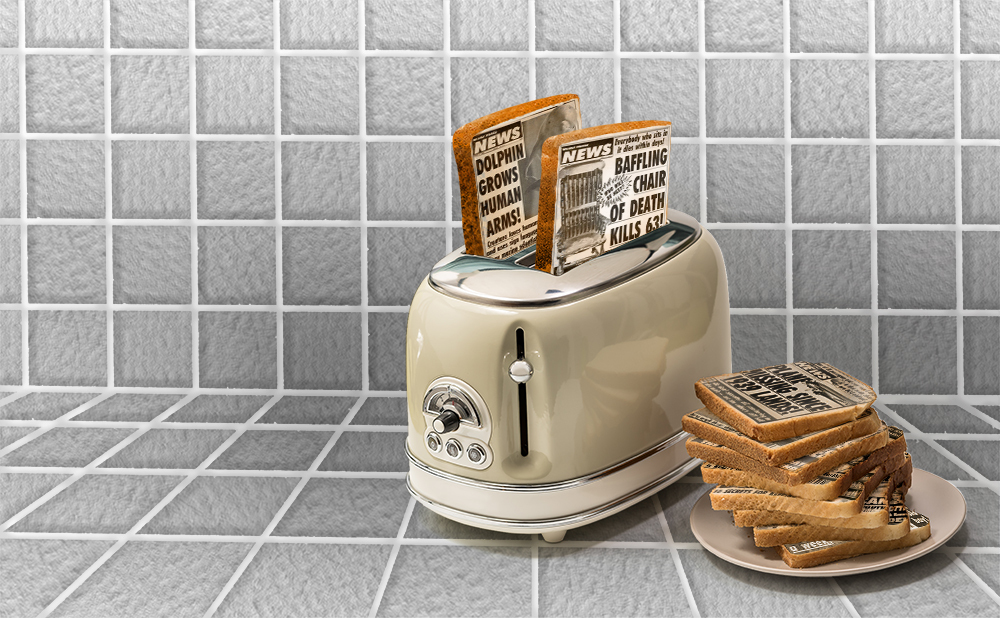 Menu
Menu
 Menu
Menu
In the 1980s and into the 1990s, North America’s best-selling fake news was Weekly World News. Calling itself “America’s Only Reliable Newspaper,” this fantastical tabloid took news and stretched it to the limit. At its peak, it sold a million copies per week.
WWN lived in print from 1979 to 2007, and maintains an online presence today. It began when the National Enquirer bought a new colour printing press. Instead of scrapping the old black-and-white press, they created a new tabloid filled with oddball stories.
Originally, about 80% of WWN’s stories were true. They soon realised that the more outlandish the news, the higher the sales. This tilted the paper towards satire. By the mid-1980s, it was mostly filled with far-fetched news and hilarious regular features.

Poorly-photoshopped photos were a staple
of WWN’s nonsensical approach to the news.
A typical edition would include absurd stories on alien abductions, religious miracles, dead celebrity sightings, the occult, and fad diets. Regular features ranged from the rude advice doled out in the Dear Dotti column, to Ed Anger’s weekly opinion piece, a satirical take on far-right blowhards.
To most readers, WWN looked silly. And the content often was coarse and vulgar. Otherwise, WWN mimicked real journalism. Its stories were written by trained journalists. They used plain language, headlines and subheadlines, bylines, eyewitness quotes, and expert commentary.
WWN’s journalistic approach made it look believable. Adding to the believability was that it included strange-but-true news mixed amongst the fake news.
Interestingly, many outlandish WWN stories were not invented by their writers. Rather, when people called in with bizarre tales, reporters tossed aside journalistic principles of fact verification and took a scribe approach. As former editor Sal Ivone said, “A lady once called us and said her toaster was talking to her. I said, ‘Put the toaster on the phone.’ We took it seriously.”
Despite being full of nonsense, WWN tried not to harm people who may end up believing their reports. Former writer Bob Lind said that heartbreak and change of behaviour set in when a reader with a deathly-ill aunt contacted them to request more details on a story about a Mexican peasant’s cockamamie cure for cancer. Likewise, former editor Dick Kulpa said they avoided things like lost treasure stories out of a fear that people may devote their lives and savings to locating it.
WWN’s mixture of fake news, real news, and call-in tales blurred the line between fiction and reality. But unlike some of today’s online fake news, the paper had little power to mislead. Most readers knew exactly what they were getting into when they picked up a copy of WWN: they were getting into fun.
Even though Weekly World News is out-of-print, its influence lives on. In the late 1980s, Onion creators visited WWN headquarters as they planned their satirical paper. The Onion adopted WWN’s method of using a veneer of journalistic standards for fake news, and staff from each paper formed long-standing friendships.

In decades past, fake news was sold at almost every supermarket check-out lane.
WWN uses the tabloid journalism format. First appearing in the late 1800s, tabloids are sensational, photograph-filled newspapers with plain-language short stories. American tabloid pioneer Randolph Hearst described them as “90% entertainment, 10% information.”
The word tabloid originated with a pill manufacturer. They combined the words tablet (a pill) and alkaloid (a medicine with several uses) to create a new word: tabloid. In 1896, Daily Mail founder Alfred Harmsworth borrowed the word “tabloid” to describe his new, sensational, plain-language newspaper. Playing off another meaning of the word tablet (a writing surface), he believed that calling the Daily Mail a tabloid would make it seem like a dose of concentrated, informational medicine.